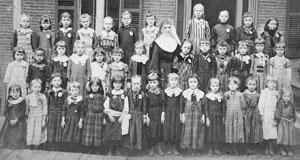
By Barb Arland-Fye
DAVENPORT — Historian, author and presidential library director Timothy Walch is not in the forecasting business, but he believes Catholic schools will survive with the determination, positive attitude and support of the faithful.
Walch made that observation March 29 during The Chair of Catholic Studies Lecture he gave at St. Ambrose University in Davenport titled: Praying to St. Jude: The Recent Contours of Urban Catholic Education.
The Chair of Catholic Studies Lecture “celebrates those whose scholarly endeavors enable the Church to pursue an understanding of the Catholic culture and a wider way of life,” St. Ambrose University President Sister Joan Lescinski, CSJ, said in welcoming comments.
Saying he was honored to deliver the lecture, Walch noted that as “the author of a general history of American parochial schools, I am always prepared for questions on the legacy of Catholic education. To my surprise, however, the Catholics I meet these days are not as interested in the past as they are in the future. They seem to have the same two questions: ‘Why have so many Catholic schools merged or closed over the past 25 years?’ And ‘will Catholic schools be around for my grandchildren and great-grandchildren?’ Tough questions, for which there are no quick or easy answers.”
Woven into his speech were five threads that he believes are contained within the fabric of Catholic education: the will to survive, variety, adaptability, community and identity.
Catholic schools in the United States have always struggled to survive, from their beginnings in the late 18th century to the present day, he said, but they’ve remained a “vital influence on the nature of public as well as private education.”
Philadelphia Catholics were believed to have established the first Catholic parish school in the U.S. in 1783; over the next two centuries, “Catholic parochial schools would educate tens of millions of American citizens without direct financial assistance from federal, state or local governments.” By the mid-1960s, the Catholic education movement had reached its high point, educating 12 percent of all children enrolled in school in the United States.
The forces leading up to these halcyon days of Catholic education were rapid industrialization, urbanization, the arrival of millions of immigrants from Ireland and Germany, subsequent anti-Catholicism and a desire by the Church, Catholic educators and parents to ensure that the children wouldn’t abandon their religious faith.
Today, Hispanic Catholics “are the fastest growing demographic cohort in American Catholicism.” But their numbers aren’t reflected in a corresponding growth in Catholic school enrollment. The opportunity for growth will be determined to a significant extent by the attitudes of Hispanic Catholic parents toward Catholic schools, Walch conjectured.
Adaptability also plays an important role in securing the future of Catholic schools, he said. He identified several models and strategies aimed at the viability of Catholic schools: vouchers, Catholic charter schools, and stewardship among them. The stewardship model, he said, began when the Wichita, Kan., Catholic community refused to close parish schools when a funding crisis loomed. “Pastors emphasized the importance of stewardship and the people responded.” Today, the Diocese of Wichita supports 39 Catholic schools because parishioners are committed to a tithing plan that allows students to attend without charge, Walch said. In Memphis, Bishop J. Terry Steib and Superintendent Mary McDonald spearheaded a campaign in 1999 to reopen nine Catholic schools in distressed inner-city parishes, placed them under diocesan control and branded them “Jubilee Schools.” Members of the Memphis business community were approached for support and responded with over $15 million for renovation of school buildings and for scholarships, Walch said. And the Archdiocese of Denver pioneered the use of market research and branding to help sustain “Schools in Urban Neighborhoods.”
But Walch believes the most innovative Catholic school model implemented over the past decade has been the collaboration known collectively as the Nativity Miguel and Cristo Rey networks. Nativity Miguel Schools serve middle school and junior high students while the Cristo Rey schools focus on high school students. Together, the networks serve almost 10,000 students in 83, non-parish-based schools in the U.S.
Integral to the success of both networks was venture philanthropist and devout Catholic B.J. Cassin, who established the Cassin Educational Initiative Foundation. In addition, the Bill and Melinda Gates Foundation granted the two networks close to $10 million in 2003 and an additional $6 million in 2006. “Cristo Rey is magical,” exclaimed Melinda Gates, a Catholic school graduate herself. “What you see there is hope and optimism.”
Walch surmises that the most important message to be drawn from this success is that these networks fit the circumstances of specific people in specific places.
Another experiment in Catholic education that has proved fruitful, he said, is a collaboration involving 16 Catholic universities in the U.S. Begun at the University of Notre Dame in 1993, “the University Consortium for Catholic Education has been the locus for collaboration and experimentation — particularly in the preparation of a new teaching corps to staff Catholic classrooms,” Walch said.








